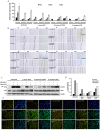Myxinidin2 and myxinidin3 suppress inflammatory responses through STAT3 and MAPKs to promote wound healing
- PMID: 29152103
- PMCID: PMC5675655
- DOI: 10.18632/oncotarget.20908
Myxinidin2 and myxinidin3 suppress inflammatory responses through STAT3 and MAPKs to promote wound healing
Abstract
Skin wounds are continuously exposed to bacteria and can easily become infected. Infected wounds require antibiotic treatment, and infections caused by drug-resistant bacteria are an important public health problem. Antimicrobial peptides have broad-spectrum antibacterial activity, induce little or no drug resistance and may be suitable for treating skin infections caused by drug-resistant bacteria. We previously reported the design and function of myxinidin and myxinidin analogues. Here we showed that myxinidin2 and myxinidin3 exhibit antimicrobial and anti-biofilm activities against antibiotic-resistant Staphylococcus aureus, Acinetobacter baumannii, and Pseudomonas aeruginosa in high salt environments and in gelatin. Moreover, these peptides facilitated infected wound healing by decreasing inflammation through suppression of IL-6, IL-8, and TNF-α and regulation of downstream mediators such as STAT3, p38, JNK, and EGFR. In a mouse skin wound model infected with antibiotic-resistant bacteria, myxinidin2 and myxinidin3 eliminated the infection and enhanced wound healing. We therefore propose the use of these peptides for treating infected wounds and burns.
Keywords: MAPKs; STAT3; antimicrobial peptide; myxinidin; wound healing.
Conflict of interest statement
CONFLICTS OF INTEREST The authors declared no conflicts of interest.
Figures








Similar articles
-
Komodo dragon-inspired synthetic peptide DRGN-1 promotes wound-healing of a mixed-biofilm infected wound.NPJ Biofilms Microbiomes. 2017 Apr 11;3:9. doi: 10.1038/s41522-017-0017-2. eCollection 2017. NPJ Biofilms Microbiomes. 2017. PMID: 28649410 Free PMC article.
-
Polyvinyl alcohol nanofiber formulation of the designer antimicrobial peptide APO sterilizes Acinetobacter baumannii-infected skin wounds in mice.Amino Acids. 2016 Jan;48(1):203-11. doi: 10.1007/s00726-015-2080-4. Epub 2015 Aug 29. Amino Acids. 2016. PMID: 26319645
-
Human platelet gel supernatant inactivates opportunistic wound pathogens on skin.Platelets. 2015;26(1):13-6. doi: 10.3109/09537104.2013.863859. Epub 2014 Jan 16. Platelets. 2015. PMID: 24433255
-
Antimicrobial Peptides and Their Therapeutic Potential for Bacterial Skin Infections and Wounds.Front Pharmacol. 2018 Mar 28;9:281. doi: 10.3389/fphar.2018.00281. eCollection 2018. Front Pharmacol. 2018. PMID: 29643807 Free PMC article. Review.
-
Novel Chronic Wound Healing by Anti-biofilm Peptides and Protease.Adv Pharm Bull. 2022 May;12(3):424-436. doi: 10.34172/apb.2022.047. Epub 2021 Mar 27. Adv Pharm Bull. 2022. PMID: 35935044 Free PMC article. Review.
Cited by
-
Pse-T2, an Antimicrobial Peptide with High-Level, Broad-Spectrum Antimicrobial Potency and Skin Biocompatibility against Multidrug-Resistant Pseudomonas aeruginosa Infection.Antimicrob Agents Chemother. 2018 Nov 26;62(12):e01493-18. doi: 10.1128/AAC.01493-18. Print 2018 Dec. Antimicrob Agents Chemother. 2018. PMID: 30323036 Free PMC article.
-
In Vitro and In Vivo Activity of 14-O-[(4,6-Diamino-pyrimidine-2-yl) thioacetyl] Mutilin against Methicillin-Resistant Staphylococcus aureus.Molecules. 2021 May 28;26(11):3277. doi: 10.3390/molecules26113277. Molecules. 2021. PMID: 34071703 Free PMC article.
-
Modulation of Quorum Sensing and Biofilms in Less Investigated Gram-Negative ESKAPE Pathogens.Front Microbiol. 2021 Jul 29;12:676510. doi: 10.3389/fmicb.2021.676510. eCollection 2021. Front Microbiol. 2021. PMID: 34394026 Free PMC article. Review.
-
Biomembrane-Based Nanostructure- and Microstructure-Loaded Hydrogels for Promoting Chronic Wound Healing.Int J Nanomedicine. 2023 Jan 19;18:385-411. doi: 10.2147/IJN.S387382. eCollection 2023. Int J Nanomedicine. 2023. PMID: 36703725 Free PMC article. Review.
-
Design, Synthesis, and Biological Activity of Thioguanine-Modified Pleuromutilin Derivatives.ACS Med Chem Lett. 2023 May 10;14(6):737-745. doi: 10.1021/acsmedchemlett.3c00004. eCollection 2023 Jun 8. ACS Med Chem Lett. 2023. PMID: 37312858 Free PMC article.
References
-
- Hoque J, Adhikary U, Yadav V, Samaddar S, Konai MM, Prakash RG, Paramanandham K, Shome BR, Sanyal K, Haldar J. Chitosan derivatives active against multidrug-resistant bacteria and pathogenic fungi: in vivo evaluation as topical antimicrobials. Mol Pharm. 2016;13:3578–89. - PubMed
-
- Dalac S, Sigal L, Addala A, Chahim M, Faivre-Carrere C, Lemdjadi Z, Bohbot S. Clinical evaluation of a dressing with poly absorbent fibres and a silver matrix for managing chronic wounds at risk of infection: a non comparative trial. J Wound Care. 2016;25:531–8. - PubMed
LinkOut - more resources
Full Text Sources
Other Literature Sources
Research Materials
Miscellaneous

